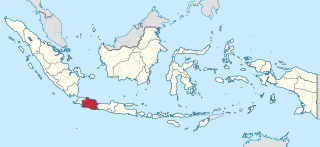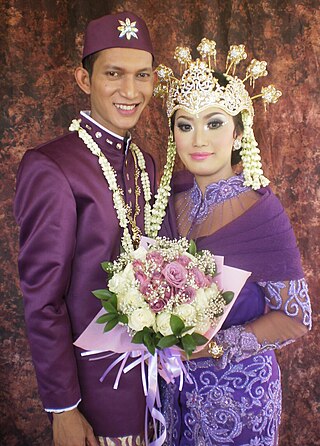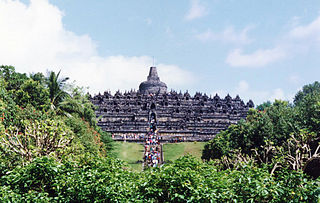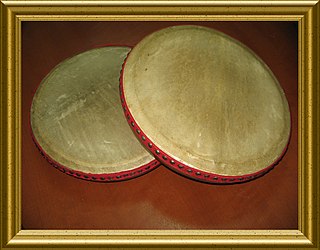
Gamelan is the traditional ensemble music of the Javanese, Sundanese, and Balinese peoples of Indonesia, made up predominantly of percussive instruments. The most common instruments used are metallophones and a set of hand-drums called kendang, which keep the beat. The kemanak, a banana-shaped idiophone, and the gangsa, another metallophone, are also commonly used gamelan instruments on Bali. Other notable instruments include xylophones, bamboo flutes, a bowed string instrument called a rebab, and a zither-like instrument called a siter, used in Javanese gamelan. Additionally, vocalists will be featured, being referred to as sindhen for females or gerong for males.

Celempungan is a Sundanese musical genre that includes several musical instruments such as kacapi, kendang, goong/gong, and suling or rebab (optional), and Juru Kawih (singer). Kendang, the drum, controls the tempo of the ensemble and reinforces the meter.

West Java is a province of Indonesia on the western part of the island of Java, with its provincial capital in Bandung. West Java is bordered by the province of Banten and the country's capital region of Jakarta to the west, the Java Sea to the north, the province of Central Java to the east and the Indian Ocean to the south. With Banten, this province is the native homeland of the Sundanese people, the second-largest ethnic group in Indonesia.
The Javanese script is one of Indonesia's traditional scripts developed on the island of Java. The script is primarily used to write the Javanese language, but in the course of its development has also been used to write several other regional languages such as Sundanese, Madurese, and Sasak; the lingua franca of the region, Malay; as well as the historical languages Kawi and Sanskrit. Javanese script was actively used by the Javanese people for writing day-to-day and literary texts from at least the mid-15th century CE until the mid-20th century CE, before its function was gradually supplanted by the Latin alphabet. Today the script is taught in DI Yogyakarta, Central Java, and the East Java Province as part of the local curriculum, but with very limited function in everyday use.

The angklung is a musical instrument from the Sundanese people in Indonesia made of a varying number of bamboo tubes attached to a bamboo frame. The tubes are carved to have a resonant pitch when struck and are tuned to octaves, similar to Western handbells. The base of the frame is held in one hand, while the other hand shakes the instrument, causing a repeating note to sound. Each performer in an angklung ensemble is typically responsible for just one pitch, sounding their individual angklung at the appropriate times to produce complete melodies.

Wayang, also known as wajang, is a traditional form of puppet theatre play originating from the Indonesian island of Java. Wayang refers to the entire dramatic show. Sometimes the leather puppet itself is referred to as wayang. Performances of wayang puppet theatre are accompanied by a gamelan orchestra in Java, and by gender wayang in Bali. The dramatic stories depict mythologies, such as episodes from the Hindu epics the Ramayana and the Mahabharata, as well as local adaptations of cultural legends. Traditionally, a wayang is played out in a ritualized midnight-to-dawn show by a dalang, an artist and spiritual leader; people watch the show from both sides of the screen.

Antaboga is the world serpent of traditional pre-Islamic Javanese mythology. It is a derivative from Shiva-Hinduism Ananta Shesha combined with Javanism. After the fall of the kingdom of Majapahit and the ascent of Islam in Java, the centre for Hinduism shifted to Bali. These days many of the old myths and legends are celebrated in the wayang performance that became a vehicle to combine the syncretic philosophies from outside with those philosophies and ideas already rooted within the local cultures and traditions.

The Sunda or Sundanese are an indigenous ethnic group native to the western region of Java island in Indonesia, primarily West Java. They number approximately 42 million and form Indonesia's second most populous ethnic group. They speak the Sundanese language, which is part of the Austronesian languages.

Wayang wong, also known as wayang orang, is a type of classical Javanese and Balinese dance theatrical performance with themes taken from episodes of the Ramayāna or Mahabharāta. Performances are stylised, reflecting Javanese court culture:
Wayang wong dance drama in the central Javanese Kraton of Yogyakarta represents the epitome of Javanese aesthetic unity. It is total theatre involving dance, drama, music, visual arts, language, and literature. A highly cultured sense of formality permeates every aspect of its presentation.

Gamelan, although Indonesia is its origin place, is found outside of that country. There are forms of gamelan that have developed outside Indonesia, such as American gamelan and Malay Gamelan in Malaysia.

Hyang is a representation of the supreme being, in ancient Java and Bali mythology. The spiritual entity can be either considered as divine or ancestral. The reverence for this spiritual entity can be found in the folk religions of Java and Bali, such as the Sunda Wiwitan, Kejawen, Kapitayan, and Gama Tirta. The realm where Hyang resides is called the Kahyangan, which is an Old Javanese term that literally means "the abode of Hyang", "part of Hyang", or "heaven".

Sembah is an Indonesian greeting and gesture of respect and reverence. While performing the sembah, one clasps their palms together solemnly in a prayer-like fashion called suhun or susuhun in Javanese; or menyusun jari sepuluh in Indonesian and Malay, placing them in front of their chest and moving the pressed palms up to their chin, or all the way up until their thumbs touch the tip of their nose, while bowing slightly. Any of these two forms are made depending on the status of the person greeted.

Dewi Sri or Shridevi is the Javanese, Sundanese, and Balinese Hindu Goddess of rice and fertility, still widely worshiped on the islands of Java, Bali and Lombok, Indonesia. She is often associated or equated with the Hindu goddess Lakshmi, the shakti (consort) of Vishnu.

Wawacan Sulanjana is a Sundanese manuscript containing Sundanese myths. The title means "The Tale of Sulanjana", derived from the name of the hero Sulanjana as the protector of rice plant against the attack of Sapi Gumarang cow, Kalabuat and Budug Basu boars symbolizing rice pestilence. The Wawacan Sulanjana contains Sundanese local wisdom through reverence of rice cultivation in its tradition.

Sundanese dances is a dance tradition that is a part of ritual, artistic expression as well as entertainment and social conduct among the Sundanese people of West Java and Banten, Indonesia. Sundanese dance is usually cheerful, dynamic and expressive, with flowing movements in-sync with the beat of kendang accompanied with Gamelan degung music ensemble.

Sumedang Larang is an Islamic Kingdom based in Sumedang, West Java. Its territory consisted of the Parahyangan region, before becoming a vassal state under the Mataram Sultanate.

Sundanese Music is an umbrella term that encompasses diverse musical traditions of the West Java and Banten in western part of Java, Indonesia. The term of "West Java" is preferred by scholars in this field. The word "Sundanese" originally referred to western part of Java Island and has a strong association with the highly centralized Sunda Kingdom based on Java Island and its high culture practiced by the nobleman class in its capital Parahyangan. By contrast, scholars who cover a much broader region lay emphasis on folk culture.

Buda Script or (Aksara Buda) or Gunung Script is an archaic script. Based on its shape, the Buda Script still has a close relationship with the Kawi script. This script was previously used on the island of Java and Bali. This type of script is called the Buda script because it is considered to have originated from the pre-Islamic era which is called the Buddhist Age. The word Buda is based on the Buddha word. Manuscripts containing writing using the Buda script are commonly found in mountainous areas. Because of that, this type of script is also called the "Mountain script".

Kompang is a traditional Balinese and Javanese musical instrument part of gamelan in the percussion family originated from the Indonesian region of Ponorogo in East Java. Kompang has existed in Indonesia since at least the 8th century and has spread to various regions of Indonesia as well as the Southeast Asia in general, such as Singapore, Malaysia, Brunei and Thailand, which later became known as Kompang Jawa.




















